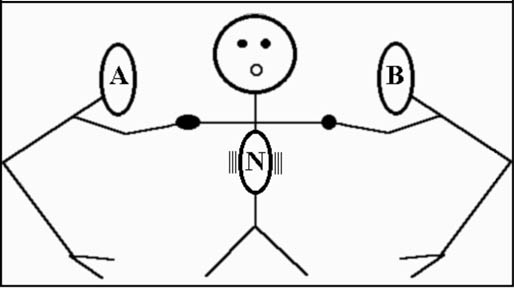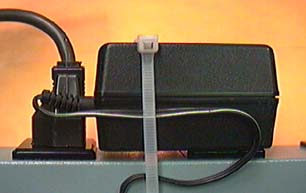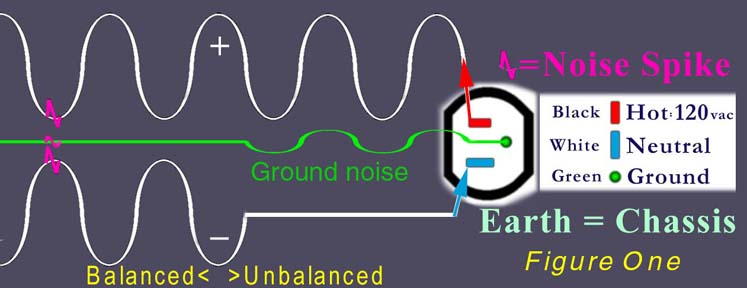A BRIEF DIVERSION...
In the typical home, youíll find a single phase of 220
volts in the breaker box. This power is reserved for large air conditioning
systems or electric ranges. From each phase-to-neutral is 120 volts, the
sauce that feeds standard appliance outlets. The electricianís goal is
to balance the loads on each phase. The analogy is tug-of-war, where you
get to be the rope, A.K.A. Neutral. Both the "A" and "B" phases are
pulling, but so long as the load of each phase is equal, you (Neutral)
stay put.

When the load becomes unbalanced your system is likely
to pick up bizarre intermittent noises. This is especially true when more
than one outlet source is used. When possible, avoid potential problems
by plugging everything into one dedicated outlet. Before doing so, determine
the total power consumption in either of two ways: One: read the
specs either in the documentation or on the rear panel of the unit. Unfortunately,
adding up power specs may be difficult because power consumption can be
specified as Watta, Amps and VA (Volt-Amperes). Two: use an "Amprobe"
clip-on ammeter to measure the current being drawn. Be sure to add a 30%
to 50% safety margin. For example, if the total load is 10 amps, the typical
15 amp breaker will be happy. (Running too close to maximum will make the
breaker run hot or it may blow if everything is powered up at once.)
FORMULA RELATIONSHIPS
Fuses and circuit breakers are always specified in amperes
(AKA "amps"). The information on the back of the unit or in the operatorís
manual will be specified in watts (W) or volt-amperes (VA). The Power Formula
is: Power = Volts times Amps ( P = V I ). Since "I"
is the current in Amperes, "VA" is volt-amperes, which should be the same
as Watts except that the "power vector" must be considered (this detail
is not yet fully developed on this page). Since the current is "alternating"
and not "direct," we can not simply multiply volts and amps to get watts.
Expect to make a few phone calls to the manufacturer.
Meanwhile, here are a few tips to keep the beasts at bay.
-
Connect all of the gear into power strips, but
-
Donít daisy chain any power strips, yet.
-
Count all of the strips, then
-
Determine how many strips it will take to accommodate them.
-
Now, think like a tree...
-
Each piece of gear is a leaf...
-
Each branch is power strip...
-
All strips feed the trunk...
-
Which is like the main outlet, OK?
-
Some trees have two trunks...
-
It could happen!
-
If so, make sure both breakers are on the same power phase.
ISOLATED GROUND and BALANCED POWER
Is it worth the added expense?
Consider the following
An Isolated Ground (IG) can be worth the added expense, but ONLY when
approached in a very specific and consistent way. Otherwise the benefits
will be nominal at best. Almost all new systems are sonically clean,
so don't kid yourself into thinking you got what you paid for (IG) or got
away with not paying for (IG).
Assuming a New Installation
If everything is connected to the same noise source there will be no
noise. The problem with most systems is that, over time, connections
become loose. Inconsistent noises are the result of changes in temperature,
moisture and current demand over TIME.
FOR EXAMPLE
It is also important to consider the habit of electricians. Most
do house and commercial wiring, few have the sensitivity to do audio installtions.
It is quite common, for example, for outlet boxes to be run in series RATHER
THAN running a fresh wire back to the breaker box. Consider strings of
"holiday" lights where, if one bulb is pulled, the others go out.
In power distribution, daisy-chaining outlet boxes puts a potential
noise-maker at every juntion: hot, neutral and ground. Again, the tightness
of each connection is important, because the lack of same generates heat,
causing expansion (and contraction), which, over time, generates intermittent
noises into the system wiring. Power hungry appliances and audio gear could
potentially heat up every weak junction.
An Isolated Ground system requires the following:
1.) three wires: hot, neutral and insulated ground to the IG outlet.
PLUS
2.) To be legal, a metal jacketed cable securely connected to a metal
outlet box (if used). When metal studs and metal boxes are used,
there will be multiple ground connections. The isolated and INSULATED
ground wire can not be used for, nor can it touch, the metal box or metal
stud.
HOWEVER
Using the spike-in-the-ground approach, there is still the problem tht
results when all of the wires are in the same jacket. Consider that
even audio gear generates noise. The proximity of the ground wire
-- isolated or not -- to the hot and neutral means that gear noise will
be induced from the power lines into the ground wire.
To legally take full advantage of an true IG system, balanced power
distribution (BPD) is required. Yet another expense, BPD requires a power
transformer with 120 volt windings, precision center-tapped at the mid-point
to yield 60 volts (60-0-60) to both the former NEUTRAL and the somewhat
less HOT. With balanced power, minimal, if any. noise will be generated
into the ground wire, isolated or not.
IG sans BPD
To keep the ground wire clean, it should be run away from -- and not
parallel to -- the power lines. This is not "to code," but for the
moment, consider this:
In additon to the legal requirement of the standard hot-neutral-ground
cable to the outlet box, run a separate ground wire -- that is not paralllel
to any of the power lines -- to the isolated-ground outlets. ALL
of the ground wires -- legal and clean -- will go back to the same ground
bar in the breaker box. Assuming the same clean, tight connection
for every wire, the system should remain clean.
NOISE will occur if you join a clean system to a noisy system as might
occur when connecting to a guitar or bas amp via direct box. Of course,
ALL potential audio outlets should have their own ground wire and a straight
return to the breaker box.
Glossary of terms
Hertz (abbreviated Hz) is the frequency,
in cycles per second, of an alternating current (AC). When specifying voltage,
the RMS (root mean square) value is used so that the effective power is
equivalent to that of direct current (DC). For example, the voltage at
the power outlet is 120 volts RMS which is actually about 340 volts peak-to-peak.



